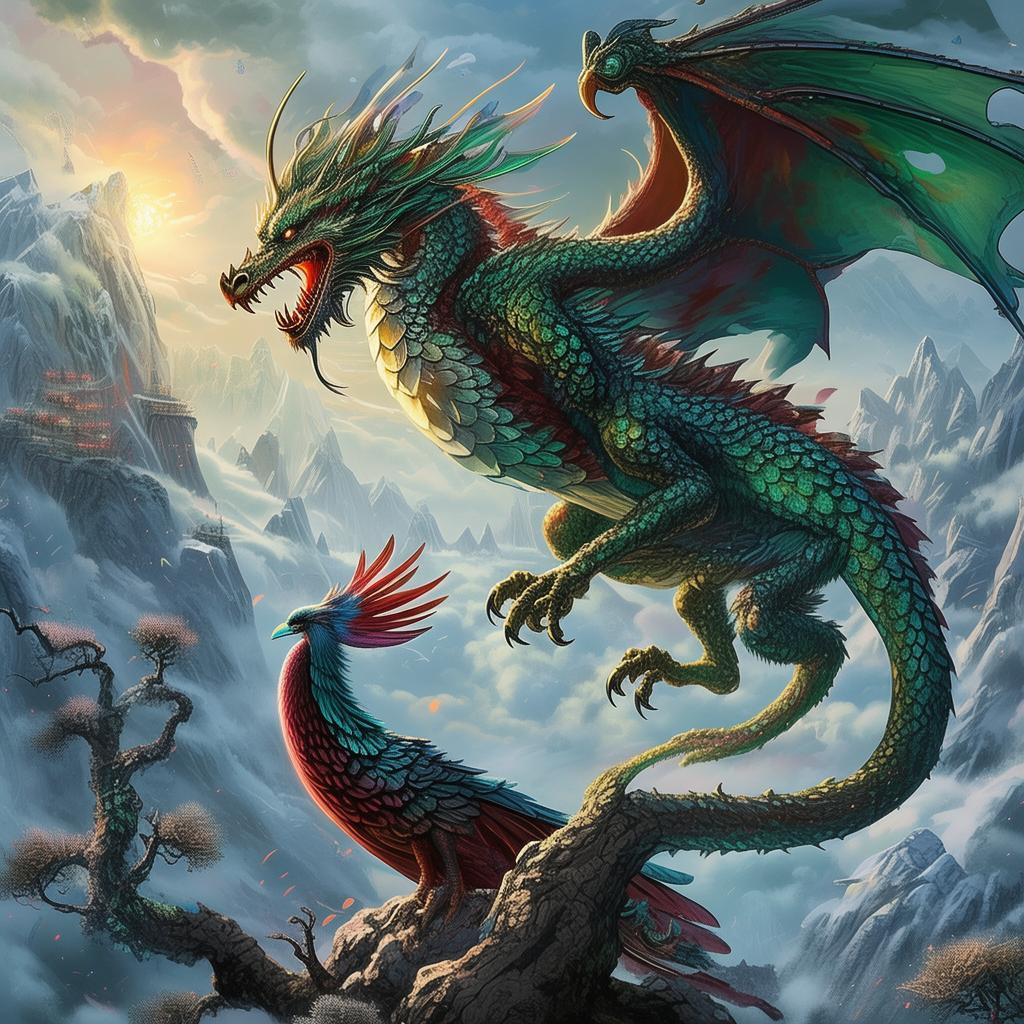The Mountain's Resilience: The Convergence of Earth and Water
In the heart of the ancient Chinese mountains, where the sky kissed the earth, there stood a mountain known as Jing Shan. Its peaks were as high as the heavens, and its roots as deep as the abyss. Jing Shan was not just a mountain; it was a living entity, imbued with the essence of Earth. Its very being was a testament to the resilience of the land, for it had withstood the test of time, defying the elements that sought to erode its strength.
In the waters of the Great River, flowing from the North to the South, there was a creature known as the Water Dragon. The Water Dragon was no ordinary being; it was the embodiment of the element of Water, a force that could shape the land and move mountains. The Water Dragon had watched over Jing Shan for centuries, a silent guardian of the balance between Earth and Water.
However, as the seasons changed and the years passed, a discord arose between the two beings. The Water Dragon, feeling the encroachment of the Earth's might, believed that Jing Shan's growth was a threat to the delicate balance of nature. The mountain, on the other hand, felt that its expansion was a natural progression, a testament to the resilience of the Earth.
The debate between the Mountain and the Water Dragon became a spectacle for the other creatures of the land. The Mountain, with its towering presence, declared, "I am the very essence of Earth. I grow not out of pride, but out of life. The more I grow, the more I support the creatures below. My roots are deep, and they hold the land together."

The Water Dragon, with a voice that echoed through the valleys, replied, "But your growth is unnatural! It disrupts the balance of the Great River. Water shapes the land, carves out canyons, and creates life. Your relentless expansion will one day lead to the destruction of the very ecosystem you seek to protect."
The creatures of the land, from the tiniest insect to the greatest of the beasts, gathered to witness the great debate. Among them was a young scholar named Ming, who had always been fascinated by the ways of the world. Ming listened intently, his heart heavy with the weight of the debate.
As the days passed, Ming noticed a change. The Mountain began to wither, its leaves turning a sickly yellow. The Water Dragon, in turn, felt its power waning, its scales losing their luster. Both realized that their conflict was not just a battle of words; it was a battle that threatened the very fabric of their existence.
In a moment of clarity, the Mountain spoke again, this time with a voice that was filled with humility. "I see now that my growth has been a result of my own ignorance. I have not considered the impact on the Water Dragon and the Great River. I will no longer grow until I find a way to coexist with the Water Dragon."
The Water Dragon, with a heart softened by the Mountain's words, replied, "And I, too, have been blind. The Great River cannot exist without the support of the Earth. We must find a way to live in harmony."
The creatures of the land cheered, for they saw the beginning of a new era, one where the Mountain and the Water Dragon would work together to maintain the balance of nature.
Ming, inspired by the wisdom of the Mountain and the Water Dragon, decided to dedicate his life to studying the ways of the elements. He sought to understand the intricate dance between Earth and Water, and how they could coexist without one overpowering the other.
Years passed, and Ming's studies brought about a new understanding of the elements. He realized that the balance between Earth and Water was not a static state but a dynamic one, ever-changing and ever-evolving. The Mountain and the Water Dragon, now living in harmony, continued to watch over the land, their bond strengthened by their shared understanding.
The story of the Mountain's Resilience became a legend, passed down through generations. It served as a reminder that even in the face of conflict, there is always a path to harmony, a way to coexist with the very elements that define our world.
In the end, it was not the strength of the Mountain or the power of the Water Dragon that won the day, but the wisdom and the resilience of both. They had learned that the true strength of nature lay not in dominance, but in balance.
✨ Original Statement ✨
All articles published on this website (including but not limited to text, images, videos, and other content) are original or authorized for reposting and are protected by relevant laws. Without the explicit written permission of this website, no individual or organization may copy, modify, repost, or use the content for commercial purposes.
If you need to quote or cooperate, please contact this site for authorization. We reserve the right to pursue legal responsibility for any unauthorized use.
Hereby declared.









